Most people thought that orchids need little light and are best grown indoors. In fact, many orchids can tolerate and some actually need a strong sun to grow vigorously with more vibrant flower colors.
Orchids that require the full sun are Vandas and Cattleya alliance plants (Cattleya, Epidendrum, Laelia, Encyclia). Oncidiums and hard-cane Dendrobiums can be trained to take the full sun although their leaves may turn a bit yellow.
The only orchids that cannot adapt to the full sun and would get sunburnt are the low-light ones, e.g. variegated orchids, Phalaenopsis, Miltonopsis, Jewel orchids, Paphiopedilums.
(Related: Light requirements of different types of orchids)
The following orchids are sun-loving varieties that thrive under the hot sun.
Vanda
Also known as “vandaceous orchids”, Vandas love full sun and are one of the few orchid species capable of producing naturally blue blossoms. Nearly all vanda species have flowers with some degree of purple or blue, with some being a solid color with others having ornate patterns. Depending on the species, the petals may have different shapes.
Vandas need full sun, hot temperatures, and plenty of humidity to thrive, as they originate throughout the tropical regions of South Asia, Southeast Asia, New Guinea, the Pacific Islands, and Queensland, Australia.
Vandas can have three different types of leaves, depending on the species:
- Terete leaved vandas – tubular in shape and rounded, in order to catch water
- Semi-terete leaved vandas – aren’t fully tubular like terete-leaved vandas or as efficient in funneling water. Their leaves are broader but not as much as strap-leaved vandas, more like halfway between strap and terete leaves.
- Strap leaves – broad, long leaves
1. Papilionanthe teres
Common name: Miss Joaquin
Miss Joaquin is a terete-leaved vanda and is the most popular terete-leaved vanda variety.
It is popular for its use in Hawaiian leis, and has been named as Singapore’s national flower.
Its flowers are purplish pink and white, with the lips a pale lavender or mauve color. The center of the bloom is deep purple. The petal’s edges are frilled, giving it a dainty look, and the plant can grow to a height of 50 cm.
Miss Joaquin loves the full sun and is native to hot, tropical climates.
2. Papilionanda Mevr. L. Velthuis
Common name: Vanda Velthuis
Vanda Velthuis is a semi-terete leaved vanda.
It is a cross between a Ple. Miss Joaquin and a V. sanderiana.
They vary in color, ranging from white to violet to pink or any combination. White is the most common color, with velvety rounded petals and a yellow center.
White Vethuis vandas are also known as “Orglade’s Snowcap.”
3. Papilionanda Ruby Prince
Common name: Vanda Ruby Prince
Named for its rich, deep violet-red flowers, the Ruby Prince is a hybrid of the Pda. Ruby and Pda. Cooperi.
Its top petals are usually bright magenta with the bottom lip dark red. Speckling is usually visible on the bottom, darker lip while the flower’s center is cream. Like other semi-terate leaved vandas, the Ruby Prince’s leaves are a mix between broad and tubular.
Because these orchids are native to jungle environments with nutrient-rich soil, the Ruby Prince needs to be fertilized about twice a week. It should be watered at the roots after drying out completely between waterings.
The Ruby Prince is native to Singapore and other Pacific islands.
4. Papilionanda Josephine van Brero
Common name: Vanda Josephine van Brero
This is a semi-terete leaved vanda.
It is a cross between V. insignis x Ple. teres.
This frilled orchid variety has rosy pink or pinkish-orange petals, occasionally coming in bright magenta, with a yellow center and darker bottom lip. As this variety’s seed parent is the Vanda insignis, the flowers may have speckles.
The species was named after the daughter of Johannes van Brero, who cultivated orchids in Java during Netherlands’ imperial occupation of the East Indies in the second half of the 1800s.
The Josephine van Brero orchid grows in full sun with high humidity, native to Java – a tropical island in Indonesia. The plant is free flowering but needs support to help it grow straight.
5. Papilionanda Emma van Deventer
Common name: Vanda Emma van Deventer
It is a semi-terete leaved vanda and is a cross between Miss Joaquin and Vanda Tricolor.
Emma van Deventeer has soft pink petals with a bottom lip usually da pink, dusty rose, or red. The petals are thin instead of rounded, and are usually speckled – due to one of its parents, the vanda tricolor, being a spotted orchid variety.
The center of each narrow petal is usually darker, with the speckles darker than the background. Each blossom’s center is rust-colored with yellow stripes.
The Emma van Deventeer is native to Java, Indonesia, and enjoys full sun and high humidity.
Anselia
6. Anselia africana
Common name: Leopard Orchid
With a unique and distinctive leopard print pattern, Anselia africana has narrow, yellow-green petals with dark brown spots – giving the blossoms a vivid contrast.
The flowers are fragrant with a sweet, fresh, floral smell and the leaves are broad and mostly flat.
This eye-catching orchid is one of the few orchids native to the African continent. Various tribes throughout Africa – including the Zulu – use the bulbs of this orchid to make a medicinal tea that scientists believe could help treat Alzheimer’s.
They can be found throughout the African continent anywhere from riverbanks to warm, sandy environments. It thrives best with temperatures ranging between 55-60 degree Fahrenheit (13-16 degree Celcius) during nights and 80-90 degree Fahrenheit (27-32 degree Celcius) during days.
Unlike most other orchid species, the Anselia africana tolerates dry environments quite well. They can be found both at high and low elevations and are one of the larger orchid species, often growing as tall as 2.5 feet (76 cm) in height.
Brassavola
7. Brassavola nodosa
Common name: Lady of the Night
This unique orchid is most recognized for its small, heart-shaped white flowers and thin, flowing leaves that resemble vines. The flowers are fragrant, giving off a soft, floral smell.
Despite its common name, the Brassavola nodosa thrives in full sun.
This orchid is native to the jungles of South and Central America, and blooms year-round.
It’s a fast bloomer and blossoms the most during the fall and winter months.
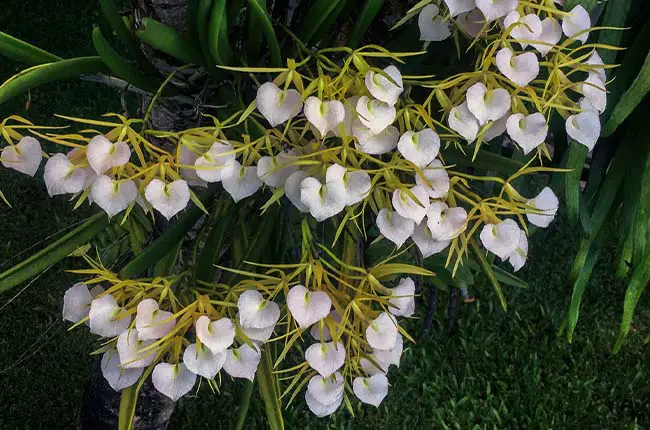
(Theleot, CC BY-SA 4.0, via Wikimedia Commons)
Cattleya
This common orchid genus is one of the most common and popular among orchids, and it’s not hard to see why. The full blooms come in rich, vibrant colors and they thrive in full sun. Cattleya is also popular to crossbreed with other orchid varieties.
8. Cattleya Skinneri
Common name: Skinner’s Cattleya
With its soft, flowing pink petals, Cattleya Skinneri is a popular orchid native to Central America.
It has broad, flat leaves. They love the sun and high humidity: the brighter the sun, the more vigorous they grow. The best temperature is 85F (29C) in the day and 58 to 60F (14-16C) at night.
It’s been seen growing from granite cliffs in its native Mexico and Costa Rica, as it thrives at higher elevations than many other orchid species.
Skinner’s Cattleya is the national flower of Costa Rica and is known in its native country as guaria morada. It blooms around Easter.
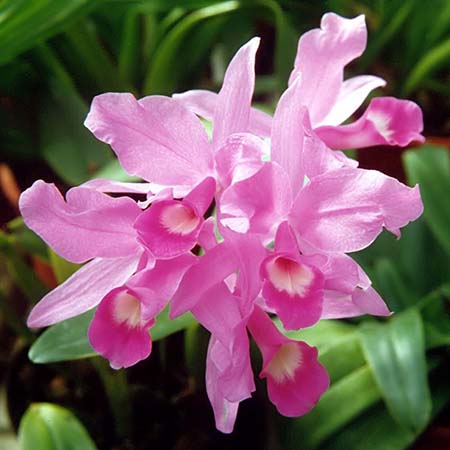
(Arne and Bent Larsen or A./B. Larsen, CC BY-SA 2.5 DK, via Wikimedia Commons)
9. Cattleya Maxima
Common name: Crownfox delicado
This orchid species has purple flowers with thin, ribbon-like petals and speckled yellow centers. Like other cattleya species, the cattleya maxima has broad, medium green leaves.
The cattleya maxima is native to South America – namely Peru and Ecuador. There is an upland variety and a lowland variety, with the upland orchid found in the Andes. The crownfox delicado is one of the larger orchids, growing up to 2.5 feet (67 cm) in height.
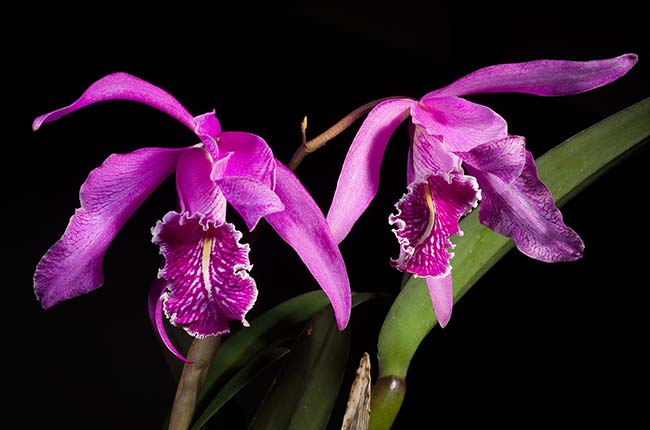
(sunoochi from Sapporo, Hokkaido, Japan, CC BY 2.0, via Wikimedia Commons)
10. Cattleytonia Why Not
Cattleytonia Why Not is a miniature Cattleya. It stays small and compact that grows up to 8 to 10 inch tall at its mature size.
It has cheery flowers with red petals and a yellow center. The orchid blooms twice a year and have small, rounded blossoms that are very fragrant, like most cattleya species.
It is a hybrid, created by crossing Gur. aurantiaca and Bro. sanguinea.
They are native to the hot, humid climates of South and Southeast Asia, specifically India.
Hard-Cane Dendrobium
Hard-cane dendrobium has stems that resemble bamboo and are evergreen which keep their leaves in the winter.
They are not to be confused with the soft-cane dendrobiums (e.g. Dendrobium Nobile) which are deciduous and lose their leaves in cold weather.
From their spikes that grow from the top of the stem, breathtaking flower sprays emerge in a multitude of colors – purple, yellow, and white being the most common.
They can handle warm to hot temperatures up to 86 degrees Fahrenheit (30 degrees Celcius) and can tolerate full sun for a few hours.
Their leaves are rather rigid and could snap when they are bent and the flowers appear only at the tip of a mature cane.
Native to Southeast Asia, hard-cane dendrobium needs full sun to thrive, and does best in a sunny windowsill with southern sun exposure. They are one of the tallest orchid species, growing more than 4 ft. in height.
Here are some popular hard-cane dendrobium types:
11. Dendrobium bigibbum
Common name: Dendrobium phalaenopsis,Cooktown Orchid
Dendrobium phalaenopsis is so-called because it has large, pink flowers with petal shape that look like Phalaenopsis flowers. It also has broad leaves.
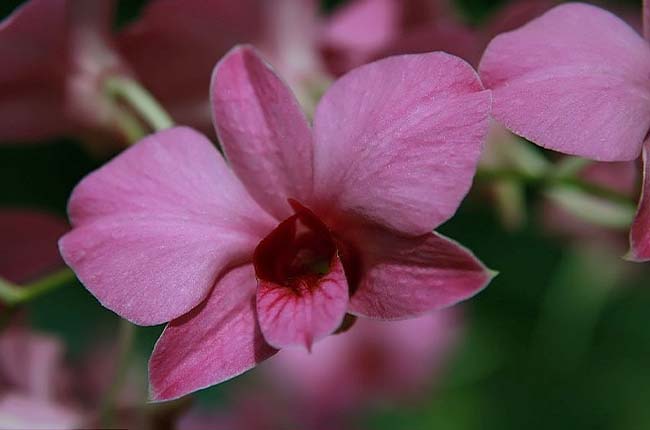
12. Dendrobium spatulata
Common name: Antelope Orchid
Dendrobium spatulate are characterized by their spirally twisted petals and asymmetrical flowers. They thrive in warm, tropical full-sun conditions.
Epidendrum
The genus epidendrum consists of over 1,000 species and does best when grown in greenhouses rather than long-term outdoor planting. Their flowers have narrow petals and come in a range of colors such as purple, pink, white, yellow, and orange.
13. Epidendrum ellipticum
Epidendrum ellipticum has clusters of small cream-colored flowers and is also known as the Elliptic Epidendrum.
Native to South America, this species blooms during the summer and spring.
14. Epidendrum quitensium
Native to Ecuador, this epidendrum species is also known as the Quito Epinendrum and has asymmetrical, hot pink blossoms.
They are found at higher elevations than most orchid species and can tolerate cooler temperatures.
Laelias
With ribbon-shaped petals that come in a variety of lovely colors, laelias are among the most fragrant orchid genera and are often crossed with other orchids for unique hybrids.
They thrive in bright conditions but will scorch and wither under direct sunlight, so protect them with a sheer curtain between the plant and the window.
15. Laelia Briegeri
This orchid species has cheerful, bright yellow flowers and is native to Brazil.
Known as Brieger’s Laelia, this species tolerates high elevations and cooler temperatures.
16. Laelia anceps
Native to Mexico, this species has dainty pink flowers that are darker pink at the tips of the petals. This species is known as the Two-Edged Laelia, or El Toro in Mexico.
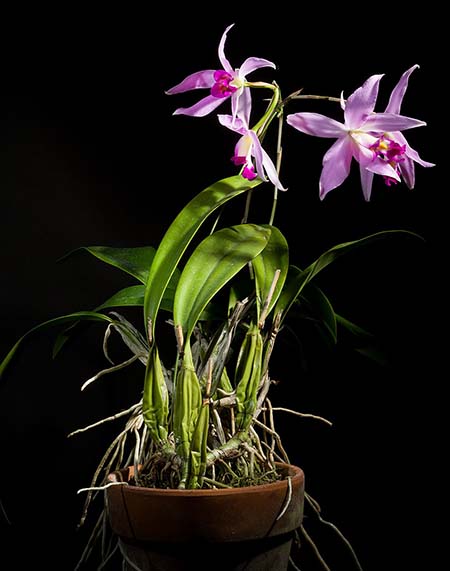
(sunoochi from Sapporo, Hokkaido, Japan, CC BY 2.0, via Wikimedia Commons)
Oncidium
17. Oncidium Flexuosum
Common name: Dancing Doll orchid
This orchid is characterized by its small, papery flowers with yellow petals and brown patches. The broad leaves are medium green.
It grows up to 9 inches (23 cm) and thrives in strong light.
It is native to Brazil and Argentina.
Spathoglottis
The genus of Spathoglottis has about 40 species, all of which need full sun.
18. Spathoglottis plicada
With its broad leaves and colorful flowers that sport a unique fading pattern, it’s no wonder why spathoglottis orchids are among the most beautiful.
Spathoglottis makes a great beginner orchid due to its ease of care.

(Girish Mohan PK, CC BY-SA 4.0, via Wikimedia Commons)
Can orchids grow in full sun?
The orchids you get from the shops and nurseries cannot take the full sun without acclimatization. This is because they are raised under a shade-cloth in a greenhouse or are kept inside a store before they are sold and so they are adapted to the filtered lighting.
Even for sun-loving orchids like vandas, those from a store or nursery could easily get sunburnt and damaged if they are put under full sun.
They need to be trained and acclimatized over a period of time slowly before they are introduced under the sun.
Bright light vs. Full sun
It is important to mention that when people say they have successfully grown orchids under the sun, you would need to know whether the location of the orchid is receiving direct sunlight on a balcony under a roof, on the side of a tree, or against a wall receiving direct sunlight for only a few hours a day.
Also, the sun versus the sun in more temperate climates is not the same.
How to transition orchids outdoors?
To transition orchids from the store and nursery, they need a transition period of one to a few months before they can be adapted to stronger lighting outdoors.
First, move them to a location a shade brighter than their previous location for a couple of weeks. It could be by an east-facing or west-facing window or on a balcony, where they get half day of sun.
Gradually, move them to stronger light. This could be outdoors under a tree or on a screened patio with filtered sun. Let the plants spend a couple of months or until they develop new roots and a new structure, e.g. a new leaf, pseudobulb. They would then be fully acclimatized and can be moved to a spot under full direct sun.
Maintain good moisture level and ventilation during the transition.
When is the best time to acclimatize orchids outdoors?
The end of winter is spring is the best time to change the growing environment (including lighting) of orchids because the sun is not the strongest and they begin an active vegetative growing phase.
Which is your favorite full-sun orchid? Tell us in the community.
Related:
How Much Light Do Orchids Need? (with Light Chart)
Best Grow Light For Orchids: Buying Tips & Setting Up
8 Unique Miniature Cattleyas (with Large Blooms )
- Top 6 Drip Irrigation Systems for Raised Beds (2025) - January 31, 2025
- Top 10 Orchid Fertilizers: A Comprehensive Review (2025) - January 16, 2025
- Top 6 Slow-Release Fertilizers for Houseplants & Veggies (2025) - January 15, 2025
